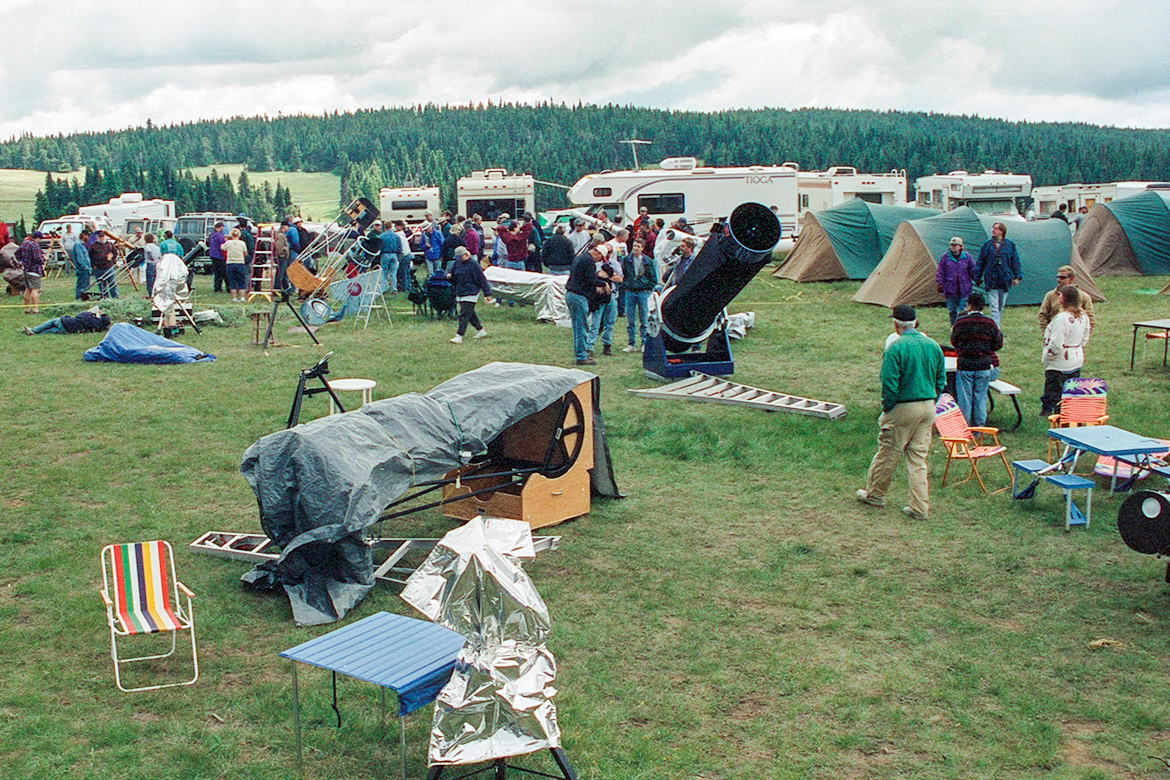
I started lugging stuff out of my car and was struggling with my oversized tent when I met my neighbor to the east, Barry, a friendly bearded fellow who reminded me of a mild-mannered graduate student. In reality he was a programmer, but his interests fell strongly in the areas of ham radio and astronomy. He was modest about his beginner status in astronomy, but he had attended prior years of TMSP and enjoyed them immensely, hence his return this year.
Barry felt responsible for letting me know that the rear tire on my car was flat. I was surprised at this news, since I had just arrived and had not experienced any sort of tire problems on my way up the mountain, but there it was. It wasn’t just low on air– it was dead flat! Had I been driving on a rubber-covered rim all the way up that road? I suppose it’s possible, but let’s instead think that it must have happened as I maneuvered into the field. A sharp rock maybe?
Barry inspected more closely and found a nail embedded in the tire. More mystery, but what to do for now? We made a plan. Prop the car up on big rocks to avoid further damage to the tire, and then see about getting to town tomorrow. This sounded good to me; I was fine with putting the problem off. I had more important things to do.
Like find something to eat. I had pre-registered for the star party, and one of the options was to sign up for several meals were offered during the event. It was not difficult to decide that if someone else would take on the overhead of preparing food, I would be happy to consume it. I had the meal tickets in my pocket, but on arriving at the food tent, I found that I was moments too late. The operation had shut down, the kitchen was being cleaned up. But recognizing my haggard state from driving all day, the cooks found some remaining foodstuff to satisfy my immediate calorie demand. I did have some provisions in my car, so it wasn’t a real emergency, but it was nice that the food guys were so accommodating.
After meeting this priority, I could now fully engage in the essence of the star party. I was in the ideal dark sky location and intended to take full advantage of it. I assembled my mount, telescope and camera adapters. The light was fading, and I was able to do a “drift alignment”, a lengthy but precise method of aligning the telescope mount to the polar axis of the Earth’s rotation. I took a look at Mars, the brightest thing in the sky, and then located my first photographic target, the Trifid nebula. The next step was to find the proper focus. With my f/4 scope, I had to find the exact location to place the film to within 50 microns. I had never reliably succeeded at this, so I wanted to figure out a method to achieve it. As I struggled with finding the “knife-edge focus” on a nearby bright star, I noticed that the nearby bright star wasn’t very bright anymore. In fact, it would periodically disappear. Then it disappeared altogether. Looking up, I saw that the sky had been overtaken by clouds. There were occasional openings, but otherwise it was completely opaque.
I abandoned my scope and decided to catch up on my note-taking and general metabolism recovery. The temperature had cooled rapidly after sunset and I was almost too late in putting on my various additional layers of clothing. Eventually, not seeing any change in the cloud cover, I proceeded to disassemble everything and pack it up. I considered going to bed and making up for days of sleep shortage accumulated while traveling.
My neighbors to the west appeared. Scott and Matt, members of the Portland “Rose City Astronomy Club”, returned from their sessions in the telescope field. Remember, I was in the overflow area; most of the participants had set up in an enormous alpine meadow, the “telescope field” on the other side of the RV mosh pit. Scott and Matt both had large, personally hand-designed and crafted Dobsonian telescopes out in the middle of the field and had been there observing all evening, up to the moment of full cloud cover, and then returned to their base camp next to me.
Striking up a conversation with them was easy, then inspirational. This is why star parties can be a success regardless of observing conditions. The passions for the night sky become even more intense when observing is thwarted, and finding others with similar passions will only fire them up further. Scott and Matt were active members in their club and their obvious enthusiasm was infectious. “Think of what we might be seeing, if only we could see it!”
After enough talk with the neighbors, we looked up to discover that the skies had cleared! It was a bit too late for me to go through the full setup procedure again: by the time I finished it would be dawn, but the Dobsonian boys could instantly re-insert their eyepieces and be cruising the skies in a moment. And so, I was invited to the telescope field to look through two award-winning telescopes. I was in the middle of a desert, at an elevation of over 6000 feet with no large cities within hundreds of miles and looking through large aperture telescopes at the treasures of the night sky. It was a peek at Heaven.


Pingback: Table Mountain Star Party | Thor's Life-Notes
Pingback: 2.3 Rainy Days, Espresso Nights | Thor's Life-Notes